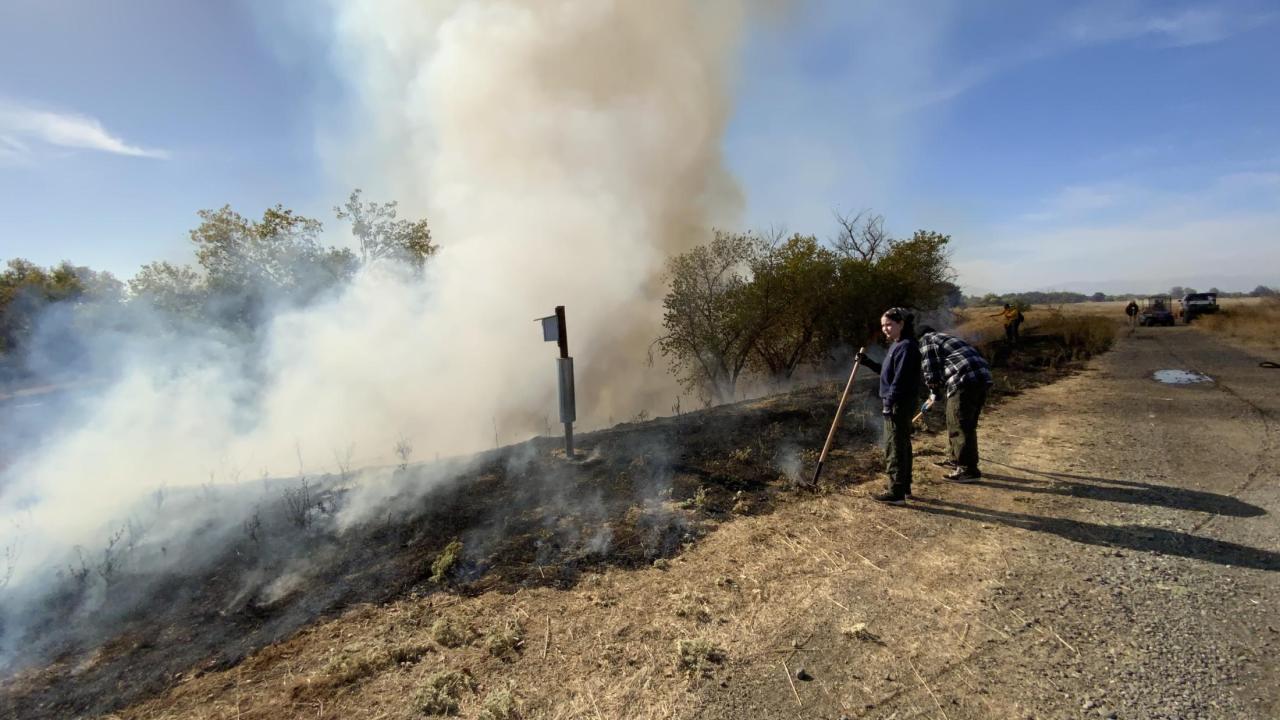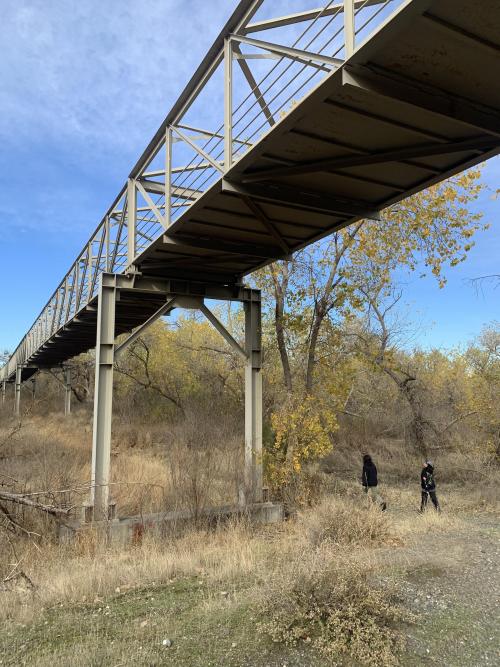
The College Corps Effect
Finding Purpose in the Field
On a clear fall day, Parker Lamos steps onto the trails of Cache Creek Nature Preserve, the morning air crisp with the scent of damp earth and sage. They check their gear before heading out to assess the preserve’s beaver dam activity. It’s a far cry from the reptile shop where their love of animals first took root, but it’s exactly where they want to be.
“I was so excited when I found out I was placed at Cache Creek,” Parker recalls. “It was my top choice.”
By the time Parker, a second-year animal science major, heads back to UC Davis at the end of the day, their boots are caked in mud, their hands bear traces of soil, and their mind buzzes with new knowledge. Whether they’ve been clearing invasive weeds, monitoring trail cameras for wildlife, or standing on a fire line during a cultural burn, each experience reinforces a lesson that textbooks alone could never fully teach — conservation is deeply connected to the land’s history and the people who care for it.
Parker is a College Corps fellow at Cache Creek Conservancy, a nonprofit dedicated to restoring and protecting the riparian ecosystem along Cache Creek in Yolo County. Through the UC Davis College Corps program, students like Parker gain hands-on experience while providing vital support to community partners tackling pressing challenges like climate change, food insecurity and K-12 education.
A Living Classroom

Parker’s love for animals began with volunteering at a local reptile store in their hometown of Lathrop, California. “I would do outreach programs and school presentations,” Parker said. “That’s where I fell in love with working with animals.” Initially interested in zoology, classes at UC Davis introduced them to the broader world of conservation biology. When they applied for College Corps, they hoped for an opportunity to work directly with wildlife.
At Cache Creek Conservancy, every day brings a new challenge. “One of the most exciting things I’ve done is participating in cultural burns,” Parker said. The cultural burns, led by experts and educators with the Yocha Dehe Wintun Nation, teach fire professionals how to manage invasive species while revitalizing native plant life. “Learning from tribal elders like Diana [Almendariz] from the Wintun tribe, and hearing her stories, was incredibly powerful,” Parker said.
Cultural burns, a practice long used by Indigenous communities to manage habitats, are a core part of the Conservancy’s land stewardship. Many invasive species struggle to withstand fire, while native plants thrive. The burns also replenish soil nutrients and reduce the risk of catastrophic wildfires.
“Growing up in California, wildfires were always seen as destructive,” Parker said. “But these burns are done with intention, and they help fire happen less frequently in the long run.”
Beyond fire management, Parker has taken part in setting up trail cameras, surveying plant species, dissecting owl pellets to study small mammal populations, and monitoring beavers that persistently dam an outflow channel. “It’s a constant battle with them,” Parker laughs. “I come home muddy almost every day, but it’s so rewarding.”
A Community Partnership That Makes a Difference
For the Conservancy, having College Corps fellows like Parker has been a game-changer. “This is our first year working with College Corps, and it’s been incredibly valuable,” said Felicia Wang, a restoration biologist at the Conservancy.
Initially, the plan was for College Corps fellows to help restore a former gravel mine site with potential for native habitat recovery. However, bureaucratic delays meant the Conservancy had to pivot. Instead, students focused on projects at the main preserve: managing invasive species, prepping fire lines, maintaining trails, and assisting with habitat monitoring.
“It’s especially helpful to have students who stick around long enough to see the results of their work,” Wang said. “Restoration isn’t instant. Seeing a project evolve from start to finish makes the experience more rewarding.”
College Corps, a state-sponsored program that offers students financial support in exchange for community service, has been transformative for Parker. “I initially applied because I could use the supplemental income,” they said. “But the experience I’ve gained has been beyond what I ever expected.”
The Ripple Effect

For Parker, the impact of the College Corps program extends far beyond the fieldwork. College Corps also provides professional development support, from resume workshops to career mentoring. For students from underrepresented or low-income backgrounds, these resources can be game-changing.
“I’m not first-gen in the traditional sense, but my dad didn’t graduate high school,” Parker said. “And financially, the program’s stipend helps a lot. It allows me to focus on getting experience instead of worrying about making ends meet.”
Parker also gained practical skills that will be invaluable in their career. One of the biggest benefits? Networking. “Before this, I was really nervous about talking to professors and researchers,” Parker said. “Now, I work alongside them, have regular conversations with grad students, and feel so much more confident. It’s changed how I see myself in this field.”
That experience is already shaping Parker’s career trajectory. “I know I want to work with wildlife, maybe in state parks or conservation,” they said. “I don’t have it all figured out yet, but this experience has given me a clearer idea of what’s possible.”
And while they may not have a definitive career plan yet, one thing is certain: the skills and knowledge gained at Cache Creek will stay with them for years to come.
“I can walk onto the preserve now and point to plants, recognize them, know their role in the ecosystem,” Parker said. “That feels amazing.”
For students, for community partners, and for the landscapes they work to restore, College Corps isn’t just an internship. It’s an opportunity to grow, contribute, and discover a sense of purpose, one muddy step at a time.
